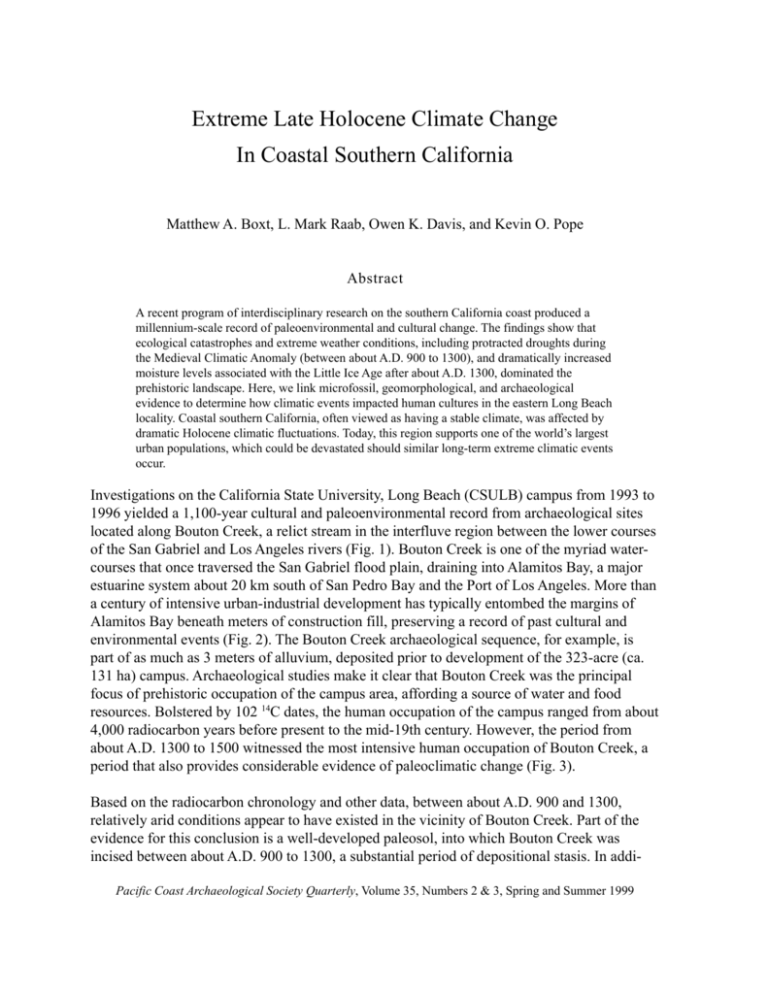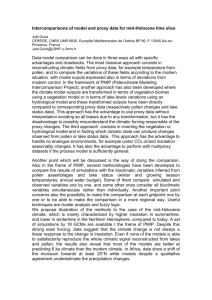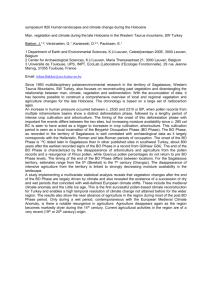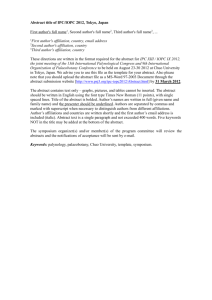Extreme Late Holocene Climate Change In Coastal Southern
advertisement

Extreme Late Holocene Climate Change In Coastal Southern California Matthew A. Boxt, L. Mark Raab, Owen K. Davis, and Kevin O. Pope Abstract A recent program of interdisciplinary research on the southern California coast produced a millennium-scale record of paleoenvironmental and cultural change. The findings show that ecological catastrophes and extreme weather conditions, including protracted droughts during the Medieval Climatic Anomaly (between about A.D. 900 to 1300), and dramatically increased moisture levels associated with the Little Ice Age after about A.D. 1300, dominated the prehistoric landscape. Here, we link microfossil, geomorphological, and archaeological evidence to determine how climatic events impacted human cultures in the eastern Long Beach locality. Coastal southern California, often viewed as having a stable climate, was affected by dramatic Holocene climatic fluctuations. Today, this region supports one of the world’s largest urban populations, which could be devastated should similar long-term extreme climatic events occur. Investigations on the California State University, Long Beach (CSULB) campus from 1993 to 1996 yielded a 1,100-year cultural and paleoenvironmental record from archaeological sites located along Bouton Creek, a relict stream in the interfluve region between the lower courses of the San Gabriel and Los Angeles rivers (Fig. 1). Bouton Creek is one of the myriad watercourses that once traversed the San Gabriel flood plain, draining into Alamitos Bay, a major estuarine system about 20 km south of San Pedro Bay and the Port of Los Angeles. More than a century of intensive urban-industrial development has typically entombed the margins of Alamitos Bay beneath meters of construction fill, preserving a record of past cultural and environmental events (Fig. 2). The Bouton Creek archaeological sequence, for example, is part of as much as 3 meters of alluvium, deposited prior to development of the 323-acre (ca. 131 ha) campus. Archaeological studies make it clear that Bouton Creek was the principal focus of prehistoric occupation of the campus area, affording a source of water and food resources. Bolstered by 102 14C dates, the human occupation of the campus ranged from about 4,000 radiocarbon years before present to the mid-19th century. However, the period from about A.D. 1300 to 1500 witnessed the most intensive human occupation of Bouton Creek, a period that also provides considerable evidence of paleoclimatic change (Fig. 3). Based on the radiocarbon chronology and other data, between about A.D. 900 and 1300, relatively arid conditions appear to have existed in the vicinity of Bouton Creek. Part of the evidence for this conclusion is a well-developed paleosol, into which Bouton Creek was incised between about A.D. 900 to 1300, a substantial period of depositional stasis. In addiPacific Coast Archaeological Society Quarterly, Volume 35, Numbers 2 & 3, Spring and Summer 1999 Boxt, Raab, Davis, and Pope 26 Fig. 1. Map of southern California counties and the general research area. PCAS Quarterly, 35(2 & 3), Spring and Summer 1999 Extreme Late Holocene Climate Change 27 Fig. 2. Reconstruction of Late Holocene Environment at CSU Long Beach. Fig. 3. CSULB radiocarbon date frequencies between A.D. 849 and 1700 (Boxt 1999). PCAS Quarterly, 35(2 & 3), Spring and Summer 1999 28 Boxt, Raab, Davis, and Pope Fig. 4. Comparison of CSU Long Beach radiocarbon date frequency (mean intercepts per 100- year interval, n-102) with San Jaoquin Marsh moisture trend (Davis 1992), age of campus paleosol surface, and Sierran droughts (Stine 1994). tion, pollen data from this time interval reflect a dramatically more xeric vegetation community within the Bouton Creek catchment area than in recent centuries. At the same time, low fresh water discharge into the creek is indicated by incursions of salt-tolerant microorganisms from Alamitos Bay, perhaps 3 kilometer (km) distant. After A.D. 1300-1400, rapid sedimentation along Bouton Creek appears to signal the onset of the Little Ice Age, lasting for about the next 600 years (Pielou 1991). Pollen and microorganisms associated with this period indicate substantially elevated flows of fresh water, as compared to the period before about A.D. 1300. This is also the time frame in which the intensity of the human utilization of the creek increased dramatically, as indicated by archaeological data (Fig. 4). A shift to fresh water conditions likely increased the availability of food resources for the region’s ancient huntergatherers. Six major stratigraphic units have been identified during the archaeological excavation at CALAN-2616. They represent historic construction fill, overbank alluvium, flood deposit, PCAS Quarterly, 35(2 & 3), Spring and Summer 1999 Extreme Late Holocene Climate Change 29 midden, an overbank alluvium deposit with a minor midden component, and the paleosol noted earlier (Fig. 5). Phases of campus geological deposition correspond to critical environmental and cultural shifts. Southern California was colonized by Spain in 1769. From this period into the 1800s, the 3 meter-deep Bouton Creek channel began to fill with silt, presumably under the impact of erosion induced by historic land use practices. A large deluge is recorded in sediments that buried Bouton Creek and four campus archaeological sites, which corresponds to historically documented floods of the 1860s. This stratum is interpreted as a slack-water flood deposit, which likely accompanied the shift of the lower San Gabriel River channel to its current location entering Alamitos Bay. Davis (1999), in perhaps the most intensive analysis of pollen to date from a California coastal archaeological context, analyzed 71 pollen samples, taken at 5-cm increments from the depositional sequence described above (Fig. 6). The resulting pollen stratigraphy can be divided into four units that are internally consistent but distinct from one another. The lowermost Ambrosia Zone (355-320 cm below surface, A.D. 500-900) contains elevated percentages of Ambrosia (10-15 per cent) and Liguliflorae (20-40 per cent) pollen. High percentages of aquatic plants such as Alnus, Typha latifolia, and fern spores indicate lowenergy swampy conditions. The Artemisia Zone (320-280 cm, A.D. 900-1300) reveals relatively low pollen concentration, unusually high percentages of Artemisia (40-60 per cent) and high degrees of pollen deterioration. The latter is consistent with deposition on a levee of Bouton Creek during the episode of paleosol formation noted earlier. Such an environment can be expected to produce relatively poor pollen preservation. The high percentages of Artemisia are a more surprising discovery, in that values > 35 per cent of this taxon have not been found in the contemporary pollen rain west of the Sierra Crest (Anderson and Davis 1988). Such high Artemisia values could result either from the expansion of coastal sagebrush (Artemisia californica; A. palmeri) in the study area or from abundant weeds of this genus (e.g., A. dracunculus) growing on or near Bouton Creek. Either case suggests a relatively arid local environment. Furthermore, the lower percentages of the pollen of wetland plants and low pollen concentration rates suggest that the Artemisia Zone was marked by lower available moisture than the previous Ambrosia or subsequent Liguliflorae zones. Soil samples from this stratigraphic horizon produced microfossil evidence of fluctuating water salinity, including minute marine ostracods (Candona sp., Cytheridea sp., and Cyprideis sp.), and non-economic molluscan species (e.g., Heterodonax bimaculata, Sanguinolaria nuttallii, Tagelus californicus, and Ostrea lurida) (Hurd and Stokes 1999). The Liguliflorae Zone (280-85 cm, A.D. 1300-1700) is marked by patterns that probably have more to do with human occupation than paleoenvironmental forces. The Liguliflorae is a tribe of the sunflower family that contains many herbs associated with vegetation disturbance. The introduced dandelion (Taraxacum officinale) and chicory (Cichorium intybus) are examples. PCAS Quarterly, 35(2 & 3), Spring and Summer 1999 Boxt, Raab, Davis, and Pope 30 Fig. 5. Test excavation unit 8 (2m x 2m), CA-LAN-2616, south sidewall profile. PCAS Quarterly, 35(2 & 3), Spring and Summer 1999 Fig. 6. Archaeological site CA-LAN-2616 pollen diagram. Abundant types (> 2% shown). Horizontal lines mark Pollen Zone boundaries. Pollen concentration at left. Note the scale change for types at right. Extreme Late Holocene Climate Change 31 PCAS Quarterly, 35(2 & 3), Spring and Summer 1999 32 Boxt, Raab, Davis, and Pope However, this pollen type also is found in certain plants native to coastal southern California, which are not associated with vegetation disturbance; for example, elegant microseris (Microseris elegans) and silver puff or small-flowered Douglas microseris (Microseris douglasii). High percentages of Liguliflorae (30-60 per cent) are produced by a variety of “disturbed ground” plants seen in other coastal California archaeological contexts (Davis 1992). As the pollen of these plants is insect-dispersed, the pollen is not transported in abundance far from the parent plants. The Liguliflorae Zone records conditions of intense disturbance that correlate well with the relatively abundant archaeological evidence found in this stratum. A high frequency of charcoal fragments (charcoal: pollen grains= 50:1) in this zone also points to intense human use. The uppermost Chenopodiaceae-Amaranthus Zone (85 cm to surface, post-A.D. 1700) records vegetation changes incident to Euro-American colonization of southern California. The sporo-pollens contained in the sediments of Bouton Creek are probably reflective of conditions in comparatively localized catchments; that is, of environmental trends, including precipitation, on the coastal plain of southern California. Accordingly, streams such as Bouton Creek are likely to yield local but less “noisy” paleoenvironmental signals than the deposits produced by rivers or streams draining much larger areas. Evidence from the Artemisia Zone suggests that the coastal flood plain in the region of the study area experienced marked aridity from about A.D. 900 to 1300. We hypothesize that the Bouton Creek paleosol is attributable to a prolonged regional decrease in stream deposition, rather than simply a single case of channel abandonment. The Bouton Creek data are also interesting when considered in light of contemporaneous global and regional paleoenvironmental trends. Comparative research shows that the climate system shifted rapidly from one state to another, frequently involving major swings in temperature and precipitation. Holocene climate shifts in North America were not only surprisingly rapid, but involved both drought and flood events of greater magnitude than those identified during the historic or modern instrumented eras (Overpeck 1996). Emerging evidence indicates that decades- to centuries-long droughts struck many regions of North America, including California (Jones et al. 1999). In this discussion we present evidence that coastal California, never regarded as particularly prone to dramatic climate flux, was affected by these events. A variety of evidence from the Sierra Nevada to the Pacific Ocean suggests that late Holocene California droughts were particularly acute in the interval between about A.D. 900 to 1300, variously labeled as the Little Climatic Optimum, Medieval Warm Period, and Medieval Climatic Anomaly (or MCA, the term used in this discussion). Graumlich (1993), for example, reports a l,000-year tree-ring record which indicates more severe and prolonged droughts during the MCA in the southern Sierra Nevada than during the present century (A.D. 1020-1070, 1197-1217, 1249-1365). PCAS Quarterly, 35(2 & 3), Spring and Summer 1999 Extreme Late Holocene Climate Change 33 In close agreement with Graumlich, Stine (1994) found two synchronous episodes of “epic” drought, between about A.D. 892 to 1112 and A.D. 1209 to 1350, as indicated by radiocarbon dates from trees drowned in four Sierra Nevada lakes, streams and marshes. Another indicator of dry Sierran conditions over the last 2,000 years is provided by Swetnam (1993), who found that fire scars on giant sequoias (Sequoia gigantea) peaked in frequency during the interval between A.D. 1000 and 1300. Based on analysis of fossil pack rat middens, Cole and Webb (1985) concluded that the eastern Mojave Desert was cooler after about 500 years B.P. In a study of the isotopic paleosalinity of San Francisco Bay (δ180 and δ13C values of fossil bivalve shells), Ingram et al. (1996) found marked shifts in late Holocene water salinity. Since San Francisco Bay receives freshwater from the San Joaquin-Sacramento river system, a watershed that drains about 40 per cent of California, the volume of freshwater inflow affords a more robust proxy of California precipitation trends than localized tree-ring or pollen records. Ingram et al. (1996) found considerably higher and lower freshwater inflows than historic averages. One period of decreased inflow, from about A.D. 1190 to 1240, is synchronous with the MCA. Evidence of Holocene climate change can also be found on the southern California coast. Davis (1992) reported a 7,000-year pollen record, based on a radiocarbon-dated, 6.9 meter core from the San Joaquin Marsh, located 7 km from the Pacific Ocean at the head of Newport Bay, Orange County, about 40 km southeast of the campus study area. San Joaquin Marsh appears to have experienced generally declining moisture levels during the late Holocene, until freshwater runoff increased markedly about 500 B.P., or with the onset of the Little Ice Age. The pollen stratigraphy from the San Joaquin Marsh contains marine organisms just prior to the Little Ice Age jump in moisture, reflecting a rapid shift from relatively saline to freshwater condition. Figure 4 illustrates the importance of these trends for prehistoric settlement of the CSULB campus. In Figure 4, we see that freshwater levels in the San Joaquin Marsh reached their lowest levels of the last 7,000 years between about 1800 and 600 years B.P. This is the same interval that Stine (1994) identifies as one of extreme and persistent droughts in California. In coastal California, the effects of a punishing late Holocene environment are found in recent archaeological discussions. Arnold (1992) and Raab and Larson (1997) identify patterns of site abandonment, increased rates of disease, malnutrition, and interpersonal violence along the Santa Barbara coast during the MCA (Lambert 1994; Lambert and Walker 1991). Stressrelated phenomena, such as elevated levels of disease and incidents of warfare, stemmed from the competition among prehistoric peoples for the resources which were severely diminished by the climatic changes discerned (Fischman 1996). Similarly, Jones et al. (1999) document settlement pattern hiatuses, shifting dietary regimes, sharply increased rates of violence, disruption of regional trade networks and other cultural patterns that correlate with the MCA in California, the Great Basin and in the American Southwest. Significantly, Kennett and Kennett (2000) show that these Medieval-era droughts and cultural changes in southern PCAS Quarterly, 35(2 & 3), Spring and Summer 1999 34 Boxt, Raab, Davis, and Pope California were coupled with the coolest sea temperatures off the southern California coast during the last 3,000 years. The CSULB research underscores the methodological constraints and opportunities that affect paleoenvironmental reconstructions. For example, the pollen data from deep-sea cores obtained from California have been employed for decades to reconstruct broad climatic patterns of the region since the Ice Age (Heusser 1978). It should be recognized, however, that these data necessarily yield an extremely generalized, perhaps even misleading, picture of climatic change. Unfortunately, these submarine records are the result of the mixing of pollen in the offshore water column; likely combining pollen from a variety of distinct floristic habitats that once were found in mainland stream catchments of enormous size. The resulting patterns may well capture only the most extreme climatic events. On the other hand, natural and cultural depositional records associated with ancient Los Alamitos lagoon affords relatively finegrained resolution of paleoenvironmental change in a critical transition zone between terrestrial and marine habitats on the California coast. As previously noted, 102 radiocarbon-dated cultural components have been identified by recent research on the CSULB campus. The frequency of these components across time may serve as a useful measure of Bouton Creek settlement intensity; a trend that is depressed during the Medieval Warm Period but sharply rebounds with the advent of the Little Ice Age and increased regional moisture levels. Of course, generalizations about paleoenvironmental change over larger regions on the basis of the CSULB research must be approached with caution. Even so, this research suggests that estuarine settings may be particularly productive sources of well-preserved, detailed paleoenvironmental data, and reconstruction of some of the effective environments occupied by the region’s ancient peoples (see, also, Jones and Waugh 1997). Over the long haul, comparative research on detailed cases such as CSULB seems likely to yield more refined and archaeologically useful paleoenvironmental reconstructions than broad-scale generalizations derived from earlier sea-core data. The data presented in this discussion add to a growing body of evidence for rapid late Holocene climate flux in North America, including both severe and persistent droughts and conditions wetter than during the instrumented period. The CSULB data indicate that southern California coastal settings, long thought to be climatically complacent, are productive locations for the study of climate change and the effects of extreme climate events on past human populations. With concerns about the environmental future increasingly evident in public policy discussions, it may be useful to consider that industrial civilization spread throughout North America during a period that was remarkably free of the severe climate changes that seem in evidence from the relatively recent past. These concerns afford another reason for better understanding Holocene climate change in one of the world’s most densely urbanized zones. PCAS Quarterly, 35(2 & 3), Spring and Summer 1999 Extreme Late Holocene Climate Change 35 Acknowledgements The data on which this report is based were gathered was under the auspices of CSULB and a Cultural Resources Management Plan developed by L. Mark Raab and Matthew A. Boxt in 1993. Among the many CSULB faculty and staff to whom we are indebted for their active interest and participation in this endeavor are Thomas W. Bass, Roman V. Kochan, Scott Charmack, Keith I. Polakoff, William Griffith, and Daniel O. Larson. Pollen studies were undertaken at the University of Arizona Palynology Laboratory. We thank T. Minckley and T. Moutoux for their help in the collection and preparation of the pollen specimens. A large debt is owed to a dedicated and outstandingly talented field crew who contributed to the success of the project. Figure 1 was drafted by Jason L. Toohey, Figure 2 by Kevin O. Pope, and Figure 3 by Manuel Oseguera Cházaro. References Cited Anderson, R. S., and O. K. Davis 1988 Contemporary Pollen Rain Across the Central Sierra Nevada, California: The Relationship to Modern Vegetation Types. Arctic and Alpine Research 20 (4):448-460. Arnold, J. E. 1992 Complex Hunter-Gatherer-Fishers of Prehistoric California: Chiefs Specialists, and Maritime Adaptations of the Channel Islands. American Antiquity 57 (1):60-84. Boxt, M. A., editor 1999 Reconstructing 2000 Years of Environmental and Cultural Change on the CSULB Campus: Contributions from CA-LAN-2616, the Vivian Engineering Quadrangle Site. MS on file with the CSULB Department of Physical Planning and Facilities Management. Cole, K. L., and R. H. Webb 1985 Late Holocene Vegetation Changes in Greenwater Valley, Mojave Desert, California. Quaternary Research 23 (2):227-235. Davis, O. K. 1992 Rapid Climatic Change in Coastal Southern California Inferred from Pollen Analysis of San Joaquin Marsh. Quaternary Research 37 (1):89-100. 1999 Pollen Analysis From CA-LAN-2616. In, Reconstructing 2000 Years of Environmental and Cultural Change on the CSULB Campus: Contributions from CA-LAN-2616, the Vivian Engineering Quadrangle Site. Volume compiled and edited by M.A. Boxt, pp. 260-279. MS on file with the CSULB Department of Physical Planning and Facilities Management. PCAS Quarterly, 35(2 & 3), Spring and Summer 1999 36 Boxt, Raab, Davis, and Pope Fischman, J. 1996 California Social Climbers: Low Water Prompts High Status. Science 272 (5263):811812. Graumlich, L. J. 1993 A 1000-Year Record of Temperature and Precipitation in the Sierra Nevada. Quaternary Research 39 (2):249-255. Heusser, L. E. 1978 Pollen in Santa Barbara Basin, California: 12,000 Year Record. Geological Society of America Bulletin 89:673-678. Hurd, G. H., and B. Stokes 1999 Microscopic Examination of Archaeosols from CA-LAN-2616. In, Reconstructing 2000 Years of Environmental and Cultural Change on the CSULB Campus: Contributions from CA-LAN-2616, the Vivian Engineering Quadrangle Site. Volume compiled and edited by M.A. Boxt, pp. 176-212. MS on file with the CSULB Department of Physical Planning and Facilities Management. Ingram, B.L., J. C. Ingle, and M. E. Conrad 1996 A 2000 Year Record of Sacramento-San Joaquin River Inflow to San Francisco Bay Estuary, California. Geology 24 (4):331-334. Jones, T. L., G. M. Brown, L. M. Raab, J. L. McVickar, W. G. Spaulding, D. J. Kennett, A. York, and P. L. Walker 1999 Environmental Imperatives Reconsidered: Demographic Crises in Western North America During the Medieval Climatic Anomaly. Current Anthropology 40 (2):137170. Jones, T. L., and G. Waugh 1997 Climatic Consequences or Population Pragmatism?: A Middle Holocene Prehistory of the Central California Coast. In, Archaeology of the California Coast During the Middle Holocene, edited by Jon M. Erlandson and Michael A. Glassow. Perspectives in California Archaeology, Volume 4, pp. 111-128. Institute of Archaeology: University of California, Los Angeles. Kennett, D. J., and J. P. Kennett 2000 Competitive and Cooperative Responses to Climatic Instability in Coastal Southern California. American Antiquity 65 (2):379-395. PCAS Quarterly, 35(2 & 3), Spring and Summer 1999 Extreme Late Holocene Climate Change 37 Lambert, P.M. 1994 War and Peace on the Western Front: A Study of Violent Conflict and its Correlates in Prehistoric Hunter-Gatherer Societies of Coastal Southern California. Unpublished Ph.D. dissertation, Department of Anthropology, University of California, Santa Barbara. Lambert, P.M., and P. L. Walker 1991 Physical Anthropological Evidence for the Evolution of Social Complexity in Coastal Southern California. Antiquity 65:963-973. Overpeck, J. 1996 Warm Climate Surprises. Science 271 (5257):1820-1821. Pielou, E. C. 1991 After the Ice Age. Chicago University Press, Chicago. Raab, L. M., and D. O. Larson 1997 Medieval Climatic Anomaly and Punctuated Cultural Evolution in Coastal Southern California. American Antiquity 62 (2):319-336. Stine, S. 1994 Extreme and Persistent Drought in California and Patagonia during Mediaeval Time. Nature 369 (6481):546-549. Swetnam, T. W. 1993 Fire History and Climatic Change in Giant Sequoia Groves. Science 262 (5135):885889. PCAS Quarterly, 35(2 & 3), Spring and Summer 1999




